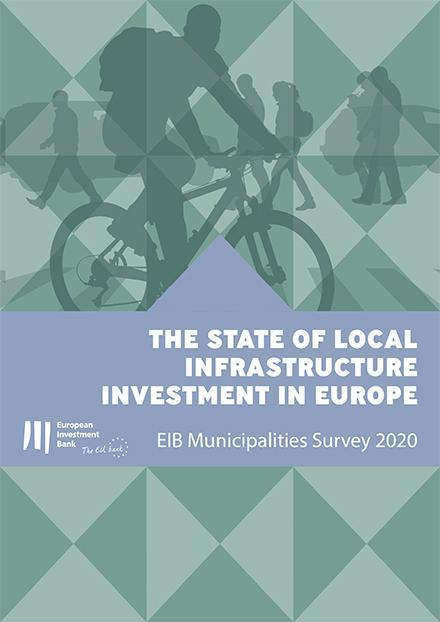
- The majority of EU municipalities report infrastructure investment gaps, especially for climate, digitalisation and urban transport.
- Two-thirds of municipalities lack the capacity to execute green projects and nearly half lag behind in digital sophistication.
Europe’s COVID-19 recovery strategy calls for large-scale public investment to “build back better.” Local authorities, such as municipalities, account for 45% of all public investment, making them a key partner in recovery efforts. As poles of social and economic activities, municipalities will also be critical to addressing climate change and improving digitalisation. In this context, a new EIB report, “The state of local infrastructure investment in Europe: EIB Municipalities Survey 2020”, published today, examines how municipal investment priorities in the EU are evolving. The report shows a clear desire by municipalities to increase investment for climate change adaption and mitigation as well as digitalisation.
- Read an online summary of the results
- Read the full report
The report is based on a unique survey of almost 700 municipalities in the European Union conducted during the summer of 2020. The results show that following a long barren spell after the global financial and European sovereign debt crisis, investment by EU municipalities had started to pick up. However, investment gaps remain while the twin — digital and green — transition is adding new ones. In response to COVID-19, municipalities are looking to refocus investment towards digital and social infrastructure. In addition to a lack of funding, regulatory red tape and limited technical capacities impede investment in climate action and digitalisation.
“Most EU municipalities are telling us that their investment remains inadequate. One of the main barriers holding back such investment are technical and planning capacities. Many municipalities are ill-equipped to master the climate and digital transition challenges,” said EIB Chief Economist Debora Revoltella. “To meet its goals, Europe must help municipalities develop the capacities necessary to deal with climate change and to promote digitalisation. The good news is that municipalities, particularly those in less-developed regions, are eager to catch up.”
“For the European Investment Bank, municipalities are key partners to channel investment into what improves people’s lives: hospitals, fast internet, climate-friendly public transport and much more. In the wake of COVID-19, municipalities are now facing new challenges that add to a backlog of a decade of underinvestment,” said EIB Vice President Ricardo Mourinho Félix. “The EU bank stands ready to support municipalities with investment and technical advice to help rebuild better after the pandemic and address the transition pressures of digitalisation and climate change.”
Investment activity of EU municipalities
Pre-COVID-19, municipal infrastructure investment had been picking up. In the three years leading up to the pandemic in 2020, nearly two-thirds of EU municipalities had increased infrastructure investment, reversing a decade of fiscal austerity. The highest increases were for digital and social infrastructure as well as climate change mitigation. There are regional differences, however. In contrast to other EU regions, where nearly three-quarters of municipalities increased infrastructure investment, in Southern Europe over half of municipalities decreased investment or kept it constant.
Increased investment notwithstanding, the majority of EU municipalities considered infrastructure investment lacking, especially for digitalisation, and climate change mitigation and adaptation, as well as urban transport.
The impact of COVID-19
By the summer of 2020, one-third of municipalities already anticipated changing their investment plans due to COVID-19. In doing so, their priorities shifted towards digital and social infrastructure. Municipalities in Southern Europe were particularly inclined to perceive a need to increase investment, notably in social infrastructure (31%), and in digital infrastructure (38%). At the same time, almost 80% of EU municipalities consider a lack of funding as an impediment to investment
EU municipalities – Green and digital administrative capacit
Administrative capacity: Green lags behind digital
Taking on the twin challenge of the green and digital transitions requires adequate administrative capacity. While there are plans for further development, the majority of municipalities exhibited gaps: nearly two-thirds report a lack of green administrative capacity (such as green budgeting) and nearly half for digital (such as provision of digital government services).
Regional differences matter, with Western and Northern Europe leading, and Southern Europe lagging behind in green, in particular, whereas Central and Eastern Europe lags behind on digital sophistication. Both regions have designs on catching up in these areas.
Background information
About the survey
The European Investment Bank’s Economics Department conducted a Municipality Survey in the summer of 2020. That survey interviewed 685 municipalities between May and August 2020, asking them to assess their infrastructure gaps, investment needs and constraints.
About the Economics Department of the EIB
The EIB Economics Department provides economic research and studies, as well as unique analysis of investment activities in the European Union and beyond, and supports the Bank in its operations and in the definition of its positioning, strategy and policy. Chief Economist Debora Revoltella heads the Department, a team of 40 economists.